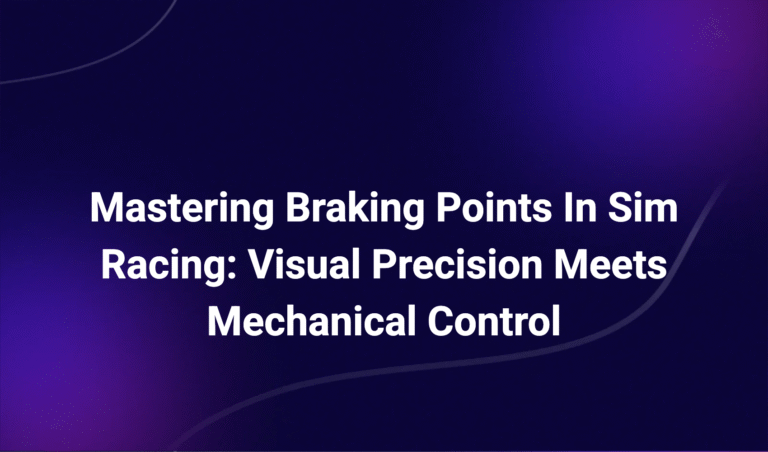Optimal Gran Turismo 7 (GT7) Settings: Precision and Immersion on Console
Introduction: GT7 Is a Simulation—If You Treat It Like One
Gran Turismo 7 (GT7) is Polyphony Digital’s most ambitious driving simulator to date, offering an elegant blend of accessibility and authenticity. While GT7 is often seen as a console-friendly simcade, with the right settings—and especially in PSVR2—it delivers a deeply immersive, technically rich experience.
However, GT7 lacks certain PC simulator essentials like true Field of View (FOV) calibration, triple monitor support, and detailed FFB telemetry export. This makes careful tuning of available options even more important.
This guide covers:
- Force feedback configuration
- Controller/wheel tuning
- Cockpit view setup (including PSVR2)
- Motion, camera, and audio settings
- Display and performance settings for clarity and precision
1. Field of View (FOV) in GT7: Understand the Limitation
❌ FOV is not user-configurable in GT7.
GT7 automatically adjusts FOV based on:
- Camera view
- Screen size
- Distance (in VR mode only)
That means you cannot manually input or match your FOV to your screen setup like in iRacing or Assetto Corsa.
What You Can Do:
- Use Cockpit View or Dashboard View only (chase and roof cams are non-realistic)
- For best realism, play in PSVR2, where FOV is adjusted to headset optics
- Sit 1.2–1.5x screen width away from your display to approximate realistic viewing angles
🧠 Pro Tip: Combine cockpit view with motion blur and camera shake disabled for clearer apex reading and braking reference.
2. Force Feedback (FFB) – The Tactile Layer of Realism
GT7 offers excellent FFB for supported wheels, especially on Direct Drive (DD) wheels like the Fanatec GT DD Pro, Thrustmaster T-GT II, or Logitech G Pro Racing Wheel.
How to Adjust:
Settings > Controllers > Steering Force Feedback
Recommended Settings:
| Setting | Value |
|---|---|
| Torque Sensitivity | 4–6 (how much torque is applied across speed ranges) |
| FFB Sensitivity | 2–4 (how sharp/strong road reactions feel) |
Per Wheel Guidelines:
- Logitech G29/DFGT: Torque = 6, Sensitivity = 3
- T300RS / T-GT: Torque = 5, Sensitivity = 4
- Fanatec DD Pro: Torque = 4, Sensitivity = 2
- Logitech Pro DD: Torque = 3–4, Sensitivity = 2
⚠️ Avoid setting Torque too high—it creates unrealistic steering weight and masks detail during high-speed cornering.
3. Camera Settings – Choose Stability Over Style
Navigate to:
Settings > Display > Camera Settings
Best View:
✅ Cockpit View (No Wheel) or
✅ Dashboard View
Recommended Configuration:
| Option | Setting |
|---|---|
| Shake on Acceleration | Off |
| Shake on Braking | Off |
| Drift Camera | Off |
| Motion Blur | Off |
| Field of View (VR only) | Automatically optimized |
🎯 A stable visual plane helps with braking consistency and visual flow. Remove cinematic camera effects to reduce disorientation.
4. PSVR2 Settings – Full Immersion With True Scale
GT7’s PSVR2 mode is one of the most immersive experiences in console sim racing.
Best Practices:
- Use Cockpit View only—available in every car
- Adjust seat height and distance to match real-world geometry
- Sit approximately 60–70cm from virtual dash
- Turn off HUD for full realism (or only keep RPM + gear)
- Use headphones for spatial audio effects
VR Comfort Tips:
- Lock camera to head movement (not horizon)
- Turn off “Look to Apex” assist
- Set steering wheel display to minimal or hidden
🔍 In PSVR2, you’ll experience true depth perception, natural car scale, and 1:1 visual cues that make rallying, time trials, and track learning feel authentic.
5. Controller Tuning – Gamepad and Motion Sense
GT7 supports both traditional controllers and motion steering.
DualSense Tuning (for controller users):
| Option | Setting |
|---|---|
| Steering Sensitivity | 7–10 (higher = quicker steering input) |
| Trigger Feedback | On |
| Adaptive Triggers | On |
| Countersteer Assist | Off (for realism) |
| Driving Line | Corners Only (or Off) |
🎮 Motion steering (tilting controller) is useful for casual play but not precise enough for competitive timing.
6. Display and Visual Settings (Console)
GT7 runs at dynamic 4K resolution with 60fps target (and up to 120Hz on supported displays).
Suggested Settings:
| Setting | Value |
|---|---|
| Resolution Mode | Performance (prioritises FPS) |
| Brightness & Contrast | Calibrated to display |
| Color Tone | Warm or Neutral |
| Camera FX | Off |
| HDR | Enabled (calibrate per display) |
🧠 Tip: Enable “Motion Smoothing” on PS5 if your TV supports 120Hz—smooths transitions during cornering.
7. HUD and Audio Configuration
HUD Cleanup:
- Show:
- Gear Indicator
- RPM
- Delta Time
- Hide:
- Map
- Driving Line (for realism)
- Speedometer (RPM is more useful)
Audio Tuning:
| Sound Element | Suggested Volume |
|---|---|
| Engine | 100% |
| Tyre Screech | 100% (critical feedback) |
| Opponent Car | 60–80% |
| Ambient | 60% |
| Spotter / Voice | 80% |
| Music | Off (during race) |
Use headphones or high-quality sound system for best gear shift and grip feedback via audio.
Final Thoughts: GT7 Is Sim-Ready—If You Configure It Right
While Gran Turismo 7 lacks manual FOV input or advanced telemetry outputs, it still provides a rewarding, physically grounded racing experience—especially with a force feedback wheel and PSVR2.
To race with realism:
✅ Use Cockpit View and stable camera settings
✅ Calibrate FFB based on your specific wheel
✅ Strip down the HUD to only essential data
✅ Use our FOV Distance Guidelines to match screen-to-eye ratio
✅ For immersion, PSVR2 is best-in-class
Dr. Vale’s content blends scientific precision with racer-focused clarity. Expect articles that don’t just explain the “how” but break down the “why” behind projection physics, spatial perception, and screen ergonomics in real-world terms. From triple screen angles to bezel compensation, Adrian’s work is grounded in empirical data and designed for competitive advantage.





